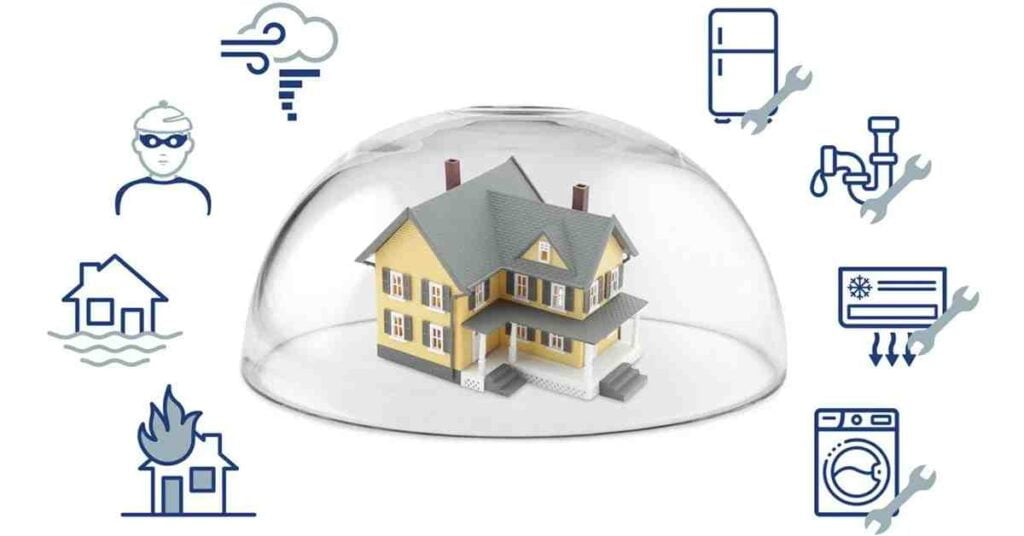Owning a home is a dream for many, but it comes with responsibilities, including getting homeowners insurance. This insurance helps protect your home and belongings from unexpected events like fires, theft, or natural disasters. However, not everyone can afford the high cost of homeowners insurance. If you find yourself in this situation, don’t worry. There are several ways to protect your home and manage risks without breaking the bank. In this article, we’ll explore practical tips and alternatives to help you navigate this challenge and keep your home safe.
Assessing Your Financial Situation
When it comes to affording homeowners insurance, understanding your financial situation is crucial. Here are some practical steps and tips to help your readers:
1. Evaluate Your Income and Expenses
- Track Your Income: List all sources of income, including salary, freelance work, investments, and any other earnings.
- Categorize Expenses: Break down expenses into categories such as housing, utilities, groceries, transportation, healthcare, and entertainment. Use budgeting tools or apps to help with this process.
2. Create a Budget
- Set Financial Goals: Determine what you need to save for, such as an emergency fund, insurance premiums, or home repairs.
- Allocate Funds: Assign a portion of your income to each expense category, ensuring you prioritize essential costs like housing and insurance.
3. Analyze Your Debt
- List Debts: Include all debts such as mortgages, car loans, credit cards, and personal loans.
- Interest Rates and Payments: Note the interest rates and monthly payments for each debt. Focus on paying off high-interest debts first to free up more money for other expenses.
4. Identify Areas to Cut Back
- Review Discretionary Spending: Look at non-essential expenses like dining out, subscriptions, and entertainment. Identify areas where you can reduce spending.
- Negotiate Bills: Contact service providers to negotiate lower rates for utilities, internet, and phone services.
5. Build an Emergency Fund
- Set Aside Savings: Aim to save at least three to six months’ worth of living expenses. This fund can help cover unexpected costs and reduce financial stress.
6. Explore Additional Income Sources
- Side Jobs: Consider part-time work, freelancing, or gig economy jobs to supplement your income.
- Sell Unused Items: Declutter your home and sell items you no longer need through online marketplaces or garage sales.
7. Review and Adjust Regularly
- Monthly Check-Ins: Regularly review your budget and financial situation to ensure you stay on track.
- Adjust as Needed: Make adjustments based on changes in income, expenses, or financial goals.
By following these steps, you can gain a clearer understanding of your financial situation and make informed decisions about affording homeowners insurance.
Exploring Alternatives to Traditional Homeowners Insurance

When traditional homeowners insurance is too costly or unavailable, there are several alternatives that can still provide protection for your home. Here are some options to consider:
1. FAIR Plans
- What They Are: FAIR (Fair Access to Insurance Requirements) plans are state-run programs that provide insurance to homeowners who can’t get coverage through the private market.
- Coverage: These plans typically cover basic perils such as fire, windstorm, and hail. They are designed to offer essential protection but may not cover all risks.
- Eligibility: Homeowners in high-risk areas or those who have been denied coverage by multiple insurers can apply for FAIR plans. Each state has its own eligibility criteria and application process.
2. High-Risk Insurance Providers
- Specialized Insurers: Some insurance companies specialize in providing coverage for high-risk properties, such as those in disaster-prone areas or older homes with outdated systems.
- Coverage Options: These providers offer policies tailored to specific risks associated with high-risk properties. For example, they might offer coverage for flood-prone areas or homes with older electrical systems.
- Finding Providers: Look for insurers that advertise high-risk coverage or consult with an insurance broker who can help find suitable options.
3. Self-Insurance
- How It Works: Instead of paying premiums to an insurance company, you set aside money in a savings account to cover potential losses.
- Considerations: This requires disciplined saving. For example, if you decide to save $1,000 per month, it would take you over 20 years to save $250,000, assuming no interest or inflation. This method is risky because a significant loss could occur before you have saved enough.
4. Small Regional Providers
- Local Insurers: Smaller, regional insurance companies may offer more affordable or flexible policies compared to national insurers.
- Advantages: These providers often have a better understanding of local risks and may offer more personalized service. They might also be more willing to work with homeowners who have unique circumstances.
- Finding Providers: Research local insurance companies or ask for recommendations from neighbors and community groups.
5. Excess and Surplus (E&S) Market
- What It Is: The E&S market provides coverage for risks that standard insurers won’t cover.
- Flexibility: Policies in the E&S market are often more flexible and can be customized to fit unique needs. This market is regulated differently, allowing insurers to take on higher risks.
- Finding Providers: Work with an insurance broker who specializes in the E&S market to find suitable coverage options.
6. Community-Based Insurance Programs
- Mutual Aid Societies: Some communities have mutual aid societies or cooperatives that pool resources to help members in times of need.
- Benefits: These programs can provide a sense of community support and may be more affordable than traditional insurance. They often operate on a non-profit basis, focusing on helping members rather than making a profit.
- Finding Programs: Look for local community organizations or cooperatives that offer these types of programs.
7. Government Assistance Programs
- Disaster Relief: In the event of a natural disaster, government programs may provide financial assistance for repairs and rebuilding.
- Eligibility: These programs often have specific eligibility requirements and may not cover all types of damage. For example, FEMA assists in major disasters but may not cover smaller, localized events.
- Finding Programs: Check with local and federal government websites for information on available assistance programs.
By exploring these alternatives, you can find ways to protect your home even if traditional homeowners insurance is out of reach.
Government Assistance Programs

Government assistance programs can provide crucial support when homeowners can’t afford traditional insurance. Here are some key programs to consider:
1. Homeowner Assistance Fund (HAF)
- Overview: The Homeowner Assistance Fund (HAF) was established under the American Rescue Plan Act to help homeowners facing financial hardship due to the COVID-19 pandemic.
- Uses: HAF funds can be used for mortgage payments, homeowner’s insurance, utility payments, and other housing-related costs.
- Eligibility: Homeowners must demonstrate financial hardship, such as a loss of income or increased expenses due to the pandemic.
- How to Apply: Applications are typically managed at the state level. Homeowners should check their state’s housing agency website for specific details and application procedures.
2. Individuals and Households Program (IHP)
- Overview: Administered by FEMA, the Individuals and Households Program (IHP) provides financial and direct services to eligible individuals and households affected by a disaster.
- Uses: IHP assistance can cover uninsured or under-insured necessary expenses and serious needs, such as temporary housing, home repairs, and other disaster-related costs.
- Eligibility: Homeowners must be affected by a federally declared disaster and meet specific criteria.
- How to Apply: Applications can be submitted through FEMA’s website or by calling their helpline.
3. State and Local Assistance Programs
- Overview: Many states and local governments offer programs to assist homeowners with insurance and other housing costs.
- Examples: Programs may include grants, low-interest loans, or direct financial assistance for homeowners in need.
- How to Apply: Homeowners should contact their state or local housing agency to learn about available programs and application processes.
4. Benefit Finder Tools
- Overview: Online tools like the Benefit Finder on USAGov can help homeowners identify federal, state, and local assistance programs they may qualify for.
- Uses: These tools provide a comprehensive list of benefits, including housing assistance, food programs, and healthcare support.
- How to Use: Homeowners can visit the USAGov website and use the Benefit Finder tool to explore available programs.
By leveraging these government assistance programs, homeowners can find the support they need to manage housing costs and maintain their homes.
Reducing Homeowners Insurance Costs
Here are some practical strategies to help you lower your homeowners insurance premiums:
1. Increase Your Deductible
- How It Helps: Raising your deductible (the amount you pay out-of-pocket before insurance kicks in) can significantly reduce your premium. For example, increasing a $1,000 deductible to $2,500 could save nearly 13% annually.
- Considerations: Ensure you have enough savings to cover the higher deductible in case of a claim.
2. Make Your Home More Secure
- Security Systems: Installing smoke detectors, burglar alarms, and deadbolt locks can earn small discounts.
- Advanced Systems: Adding a comprehensive sprinkler system and actively monitored fire and burglar alarms can lead to even greater savings.
3. Skip Small Claims
- Why It Matters: Filing small claims can increase your premiums. Some insurers offer discounts if you remain claim-free for a certain period.
- Strategy: Pay out-of-pocket for minor repairs to maintain a claim-free status.
4. Ask About Lesser-Known Discounts
- Available Discounts: Inquire about discounts for things like being claim-free, having a new roof, or being a loyal customer.
- Bundling Policies: Combining home and auto insurance with the same provider can also lead to discounts.
5. Account for Home Improvements
- Upgrades: Making improvements that reduce risk, such as updating electrical systems or reinforcing your roof, can lower premiums.
- Documentation: Keep records of all upgrades and inform your insurer to ensure you receive applicable discounts.
6. Bundle Your Policies
- How It Works: Many insurers offer discounts if you bundle multiple policies, such as home and auto insurance.
- Benefits: This can simplify your insurance management and lead to significant savings.
7. Build Your Credit Score
- Impact on Premiums: A higher credit score can lead to lower insurance premiums, as insurers often use credit scores to assess risk.
- Improvement Tips: Pay bills on time, reduce debt, and regularly check your credit report for errors.
8. Get Rid of High-Risk Items
- Examples: Trampolines, swimming pools, and certain dog breeds can increase your premiums.
- Action: Removing or mitigating these risks can help lower your insurance costs.
9. Shop Around
- Comparison Shopping: Regularly compare quotes from different insurers to ensure you’re getting the best rate.
- Review Annually: Reassess your coverage needs and shop around at least once a year to find potential savings.
By implementing these strategies, you can effectively reduce your homeowners insurance costs and make your coverage more affordable.
Community and Non-Profit Resources

When traditional homeowners insurance is unaffordable, community and non-profit resources can provide valuable support. Here are some options to explore:
1. Local Non-Profit Organizations
- Financial Counseling: Many non-profits offer free financial counseling to help homeowners manage their budgets and find affordable insurance options. Organizations like the National Foundation for Credit Counseling (NFCC) provide such services.
- Assistance Programs: Some non-profits have specific programs to assist with housing costs, including insurance. For example, Habitat for Humanity offers various forms of support to low-income homeowners.
2. Community Action Agencies
- Overview: These agencies provide a range of services to help low-income families, including housing assistance and financial education.
- Services: They may offer grants or low-interest loans to help cover insurance premiums or home repairs.
- Finding Agencies: Use the Community Action Partnership website to locate agencies in your area.
3. Faith-Based Organizations
- Support Networks: Many churches and religious organizations offer support to their communities, including financial assistance for housing-related expenses.
- Programs: These organizations often have emergency funds or programs to help members in need.
4. Local Government Programs
- Housing Assistance: Local governments often have programs to assist with housing costs, including insurance. These programs may offer grants, subsidies, or low-interest loans.
- Disaster Relief: In areas prone to natural disasters, local governments may provide additional support for homeowners to obtain insurance.
5. Mutual Aid Societies
- Community Support: These are community-based groups where members pool resources to support each other in times of need.
- Benefits: They can provide financial assistance for various needs, including insurance premiums.
6. Online Platforms and Crowdfunding
- Crowdfunding Campaigns: Homeowners can use platforms like GoFundMe to raise funds for insurance premiums or home repairs.
- Community Platforms: Websites like Nextdoor can connect homeowners with local resources and support networks.
How to Get Homeowners Insurance With An Old Roof?
By leveraging these community and non-profit resources, homeowners can find the support they need to manage housing costs and maintain their homes.
FAQs
Q 1. What is the difference between actual cash value and replacement cost coverage?
Ans. Actual cash value coverage pays for the cost to replace your home or belongings minus depreciation, while replacement cost coverage pays the full cost to replace them without deducting for depreciation.
Q 2. Can I get homeowners insurance if I have a bad credit score?
Ans. Yes, you can still get homeowners insurance with a bad credit score, but it may affect your premium. Some insurers offer policies specifically for those with lower credit scores.
Q 3. What should I do if my homeowners insurance claim is denied?
Ans. If your claim is denied, review the denial letter carefully, gather supporting documents, and contact your insurance company to discuss the decision. You can also file a complaint with your state insurance department if necessary.
Q 4. Can I insure a home that I rent out to tenants?
Ans. Yes, but you will need a landlord insurance policy, which covers the building and provides liability protection, but not the tenant’s belongings.
Q 5. What is an insurance endorsement and do I need one?
Ans. An insurance endorsement is an addition to your policy that modifies coverage. You might need one for specific items or situations not covered by your standard policy, such as high-value jewelry or home-based business equipment.
Q 6. How can I lower my homeowners insurance premium without reducing coverage?
Ans. You can lower your premium by increasing your deductible, bundling policies, installing security systems, and maintaining a good credit score.
Q 7. What is loss of use coverage in homeowners insurance?
Ans. Loss of use coverage pays for additional living expenses if you cannot live in your home due to a covered loss. This can include hotel bills, restaurant meals, and other costs incurred while your home is being repaired.
Conclusion
Finding affordable homeowners insurance can be challenging, but there are many options and resources available to help. By understanding your financial situation, exploring alternatives to traditional insurance, and taking advantage of government programs and community resources, you can find ways to protect your home without breaking the bank. Remember, it’s important to regularly review your insurance needs and stay informed about new programs and discounts that may be available. With the right approach, you can ensure your home is covered and your finances are secure.

Shubham is a passionate insurance expert with years of experience in the industry. I write about home, auto, travel, life, and health insurance to help readers make informed decisions. My goal is to break down the details of coverage, costs, and claims in a straightforward, easy-to-understand way, so you can protect what matters most without the confusion.


